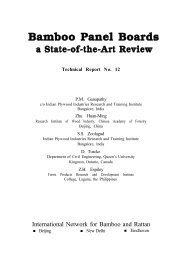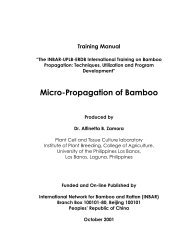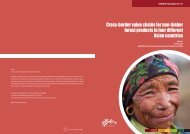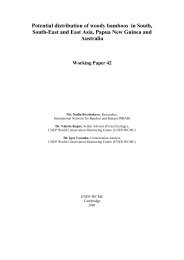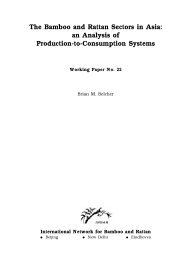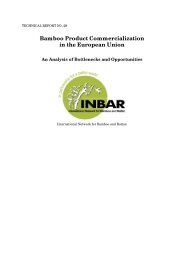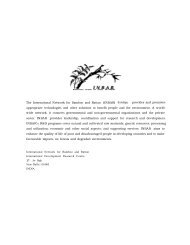ISSN ………… - International Network for Bamboo and Rattan
ISSN ………… - International Network for Bamboo and Rattan
ISSN ………… - International Network for Bamboo and Rattan
You also want an ePaper? Increase the reach of your titles
YUMPU automatically turns print PDFs into web optimized ePapers that Google loves.
phases of the moon. But this aspect was never proved beyond doubt <strong>and</strong> hence remains as a<br />
controversial subject.<br />
5.5. Economics of bamboo plantation<br />
Because of the high quality of pulp that can be obtained from bamboo <strong>and</strong> because of its availability<br />
in large quantity at a reasonable price, bamboo was used extensively as raw material in paper<br />
industry. In 1950, about 225,000 tonnes of bamboo was used in this industry in India (FRI 1951). The<br />
increasingly important role played by bamboo in the development of Indian pulp <strong>and</strong> paper industry is<br />
illustrated by Podder (1959) 14 . From a consumption of 5,830 tonnes in 1924 in India, it rose to<br />
4,50,000 tonnes in 1959. According to the report of Government of India (GOI 1961), bamboo to the<br />
level of 70 per cent was used as raw material in pulp industry in 1958–‘59. In India, bamboo <strong>for</strong>ests<br />
occupy about 10 million ha, roughly about 31 per cent of the total <strong>for</strong>est area of the country. Average<br />
yield of bamboo is 10-15 tonnes per ha per year. With a production of 3.23 million tonnes of bamboo<br />
a year, India is second only to China.<br />
The economics of industrial plantations of Bambusa bambos (Syn. B. bambos), one of the<br />
prime/dominant bamboo species in India was described by Bhat (1970) 86 . He determined the st<strong>and</strong>ing<br />
cost of production of raw material <strong>for</strong> pulping by raising B. bambos as an under-storey crop in the<br />
deciduous <strong>for</strong>ests of India, taking into account the establishment <strong>and</strong> cultural costs. The average<br />
physiological life cycle of this bamboo is reported to be 42 years, of which 2 years are spent in<br />
nursery. The remaining 40 years can be fixed as the rotation <strong>for</strong> this species, <strong>and</strong> the regular cutting<br />
cycle begins at around 10 years from planting. Shanmughavel (1995) 190 discussed the <strong>and</strong> economic<br />
aspects (costs <strong>and</strong> returns from a 6-year-old plantation) of Bambusa bambos <strong>and</strong> suggested that this is<br />
an ideal species <strong>for</strong> commercial plantations.<br />
K<strong>and</strong>elaki (1976) 103 described the investigations in Soviet Georgia on the technical <strong>and</strong> economic<br />
feasibility of utilizing home-grown bamboos as raw material in the pulp <strong>and</strong> paper industry. Selective<br />
harvesting of a high yielding plantation of Phyllostachys edulis of 3-year- old culms yielded 52.73<br />
tonnes per ha per year (as against 4.5 tonnes per ha per year <strong>for</strong> a fir plantation <strong>and</strong> 5.5 tonnes per ha<br />
per year <strong>for</strong> alder). The cost of 1 tonne of bamboo was calculated at 11.77 rubles against 44 rubles <strong>for</strong><br />
conifer pulpwood grown in Georgia. The pay-back period <strong>for</strong> a P. edulis plantation was 7 years from<br />
establishment.<br />
Specific techniques of economic analyses, ie, benefit–cost analysis, marginal analysis, budgeting <strong>and</strong><br />
market research, were suggested by McCormac (1985) 108 viz-a-viz specific bamboo resources <strong>and</strong><br />
development objectives. Wu <strong>and</strong> Xu (1987) 240 described the world level economic benefit of paper<br />
37



